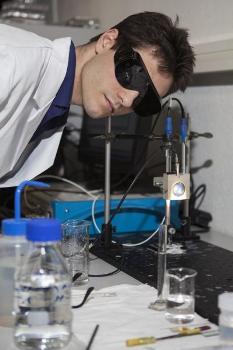Jun 19 2014
Rust – iron oxide – could revolutionise solar cell technology. This usually unwanted substance can be used to make photoelectrodes which split water and generate hydrogen. Sunlight is thereby directly converted into valuable fuel rather than first being used to generate electricity.
Unfortunately, as a raw material iron oxide has its limitations. Although it is unbelievably cheap and absorbs light in exactly the wavelength region where the sun emits the most energy, it conducts electricity very poorly and must therefore be used in the form of an extremely thin film in order for the water splitting technique to work. The disadvantage of this is that these thin-films absorb too little of the sunlight shining on the cell.
 Florent Boudoire tests the functioning of his photoelectrode in a sunlight simulator. Credit: Empa
Florent Boudoire tests the functioning of his photoelectrode in a sunlight simulator. Credit: Empa
Microspheres to collect the sunlight
Empa researchers Florent Boudoire and Artur Braun have now succeeded in solving this problem. A special microstructure on the photoelectrode surface literally gathers in sunlight and does not let it out again. The basis for this innovative structure are tiny particles of tungsten oxide which, because of their saturated yellow colour, can also be used for photoelectrodes. The yellow microspheres are applied to an electrode and then covered with an extremely thin nanoscale layer of iron oxide. When external light falls on the particle it is internally reflected back and forth, till finally all the light is absorbed. All the entire energy in the beam is now available to use for splitting the water molecules.
In principle the newly conceived microstructure functions like the eye of a moth, explains Florent Boudoire. The eyes of these night active creatures need to collect as much light as possible to see in the dark, and also must reflect as little as possible to avoid detection and being eaten by their enemies. The microstructure of their eyes especially adapted to the appropriate wavelength of light. Empa's photocells take advantage of the same effect.
In order to recreate artificial moth eyes from metal oxide microspheres, Florent Boudoire sprays a sheet of glass with a suspension of plastic particles, each of which contains at its centre a drop of tungsten salt solution. The particles lie on the glass like a layer of marbles packed close to each other. The sheet is placed in an oven and heated, the plastic material burns away and each drop of salt solution is transformed into the required tungsten oxide microsphere. The next step is to spray the new structure with an iron salt solution and once again heat it in an oven.
Capturing light simulated on the computer
Now, one could interpret these mixing, spraying and burning processes as pure alchemy – a series of steps that is eventually successful by pure chance. However in parallel to their practical experiments, the researchers have been running calculations modelling the process on their computers and have thus been able to simulate the «capturing of light» in the tiny spheres. The results of the simulation agree with the experimental observations, as project leader Artur Braun confirms. It is clear to see how much the tungsten oxide contributes to the photo current and how much is due to the iron oxide. Also, the smaller the microspheres the more light which lands on the iron oxide underneath the tiny balls. As a next step the researchers plan to investigate what the effect of several layers of microspheres lying on top of each other might be. The work on moth eye solar cells is still in progress!